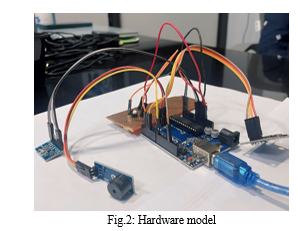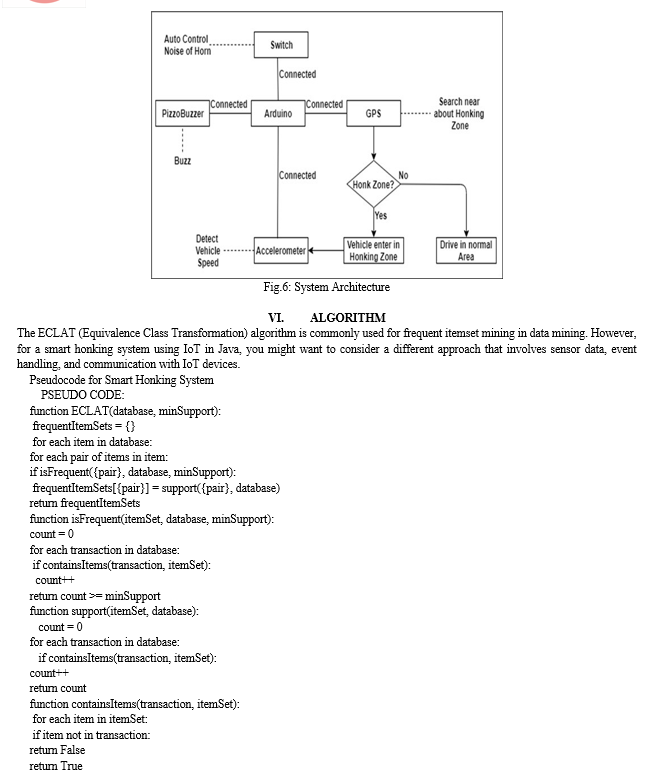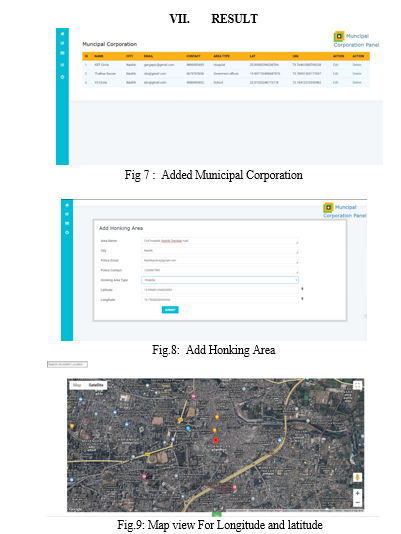Ijraset Journal For Research in Applied Science and Engineering Technology
- Home / Ijraset
- On This Page
- Abstract
- Introduction
- Conclusion
- References
- Copyright
Adaptive Honking System for Smart Cities Using IOT
Authors: Prof. Nilesh B. Madke, Abhishek Dhatrak, Aditya Dhivar, Vaibhav Agale, Akash Kshatriya
DOI Link: https://doi.org/10.22214/ijraset.2024.60571
Certificate: View Certificate
Abstract
This project has an aim to control the horn volume in cities and also in restricted area as such schools, parks, hospitals, old age homes, college, government offices and in speed limited areas etc. Some peoples are driving vehicles in a high speed and create noise of horn of vehicle. So the police are not able to monitor all those things. Driver does control the speed of vehicle at places. This paper provides a way for how to control the speed of vehicle and control the noise of horn without harming others. This project has an aim to control noise of horn automatically. The speed of any vehicles will be detected using accelerometer if the speed of vehicle is exceed in honking zone then the buzzer can buzz and get alert to driver about . cities and also in restricted area as such schools, parks, hospitals, old age homes, college, government offices and in speed limited areas etc. Nowadays in a fast moving world all the peoples are not have self-control. Controls are taken automatically by the use of electronic system. In this project we use GPS for indicating the nearby honking zone. Speed is measured by the help of accelerometer in the vehicle. The controller compares the speed. If it exceeds the limited speed the pizzobuzzer buzz and alerts the driver and controls taken automatically by driver and when vehicle is near at honking zone the switch can automatically decrease the volume of horn if it on. In this way our smart honking zone for smart cities project will be perform.
Introduction
I. INTRODUCTION
Current accidents are primarily caused by rash driving and over speeding on roads, which are increasing year to year due to more vehicles on the road. The government has taken several steps to prevent this issue, but it is not enough. Most manufacturers have developed laser-based control systems, but their cost is too high. To control these things in a simple manner, the current speed will be monitored by the separate module or the use of an ultrasonic sensor that sends information to the controller. The controller compares both speeds and the driver does not decrease the speed automatically, but the driver still operates it manually and exceeds the limited speed. The increase in vehicle pollution has caused disruptions, and in some areas, such as central cities, hospitals, and schools, honking is prohibited by law or regulation. There are many traffic signals in various areas to notify drivers not to operate horns, and local governments issue permanent or temporary regulations for honking operations. However, some drivers ignore these signs or do not know about these regulations, leading them to operate horns in a wrong way.
There is always a conscious effort to reduce speed in honking zones and avoid anger among residents. The annoyance level of traffic speed may be personal, but the community is highly sensitive to traffic noise, especially honking by vehicles. L10 is a measure of daily exposure to traffic speed and provides an indication of how much the preceding traffic noise will affect the exposed residents. According to WHO, an adverse effect of speed is a change in the morothoralogy and physiology, resulting in impairment of functional capacity.
II. DESIGN ISSUES
Many researchers have contributed to this field. Various combinations of existing technologies have been used
- "Run-Off-Road" accidents cause tens of thousands of serious injuries and thousands of highway deaths annually. Everything is responsible, including easy driver inattention, weariness, emotionlessness, and intoxicated driving. Simple sensors that are implanted with features like speed control, vehicle security, and automatic crash warning can be installed inside cars to encourage the development of effective road safety systems. During this effort, the following features are proposed: Automatic collision notice that notifies the victim's relative, Vehicle security is implemented to avoid theft, speed control modifies speed-indistinct zones, horn control forbids honking in prohibited areas, and red light control ensures that the vehicle doesn't breach signals.[1].[1]
- The ultrasonic sensor described in this work is prepared to measure the distance from the bottom of specific spots on an automobile. Based on the measurement of an ultrasonic pulse's time of flight, which is reflected by the bottom, the sensor operates. A threshold comparator is used to obtain reflected pulses that are easily observable through a limited optimization technique. This approach, which considers the ultrasonic transducers' frequency response, makes it possible to acquire a sub-wavelength detection. The sensor is capable of self-adapting to various settings in order to provide the simplest results. It is composed solely of inexpensive components, making it suitable for initial automobile equipment in many cases.[2]
- Due The rapidly growing number of vehicles on the road in recent years has led to a significant increase in traffic, which has prohibited noise pollution and made it more difficult for law enforcement to supervise vehicles. This study proposes the design of SHARP, an on-board equipment that applies a soundless horn, a traffic noise reduction mechanism for cars, and a remote watcher to help the civil force observe the vehicles remotely with an improved hit ratio of vehicles on the black list. For implementation, the suggested concept combines image processing and intersegment vehicle communication technology. The intended on-board gear is intended for four-wheelers, and a standard SHARP system consists of a camera, CPU, GPS, and DSRC transmitter. GPS device and an LCD display.[3]
III. PROBLEM STATEMENT
The ever developing times of ailments because of tempo of vehicle every physical and highbrow affords the direst need for a sustainable and an economically possible solution. The affordability and the overall performance of the solution system have to be optimized. The module moreover includes the provision of avoidance of accidents taking place because of immoderate tempo of vehicle. Mostly during the , the immoderate tempo will create an entire lot of noise pollution occurs that motives infection to the overall public nearby and people dwelling in residential areas, faculties and hospitals, antique age homes and government offices. The immoderate tempo of vehicle is may be reason of unstable accidents. The incapacity of the cause pressure to pay interest the buzzer is because of the immoderate tempo of the vehicle. Integrating with the accelerometer system of the vehicle, vehicle that routinely pauses buzzer system and allows the buzzer to be heard resulting in avoidance of avenue accidents. The affordability and the overall performance of the solution system have to be optimized. Mostly during the , the immoderate quantity of horn will create an entire lot of noise pollution occurs that motives infection to the overall public nearby and people dwelling in residential areas, faculties and hospitals, antique age homes and government offices.
IV. METHODOLOGY
The proposed methodology aims to address the issue of excessive noise pollution caused by vehicle horns in urban areas and restricted zones such as schools, parks, hospitals, old age homes, colleges, government offices, and speed-limited areas. The system design will integrate GPS technology to identify and indicate nearby honking zones and incorporate accelerometers in vehicles to accurately measure vehicle speed. Data collection and processing will involve continuous monitoring of vehicle speed using the accelerometer and identifying the vehicle's location through GPS to determine if it's in a honking-restricted zone. An automated control mechanism will be implemented to trigger alerts if the vehicle exceeds the speed limit within a honking zone, coupled with an automatic volume adjustment feature to reduce horn volume near these restricted areas. Drivers will be alerted through visual indicators on the dashboard and audible alerts via a buzzer. A user-friendly interface will be provided for drivers to adjust settings or receive notifications. Continuous monitoring and feedback collection will be integral to assessing the system's effectiveness and making necessary improvements, aiming to promote responsible driving behavior, reduce unnecessary honking, and contribute to a quieter and safer urban environment.

V. PROPOSED SYSTEM
A. Hardware Requirement
- Processor i3: An Intel i3 processor, typically found in entry-level computers, providing basic performance for everyday tasks like web browsing and office work.
- Hard Disk 5 GB: Storage device capable of holding up to 5 gigabytes of data, suitable for basic file storage needs but limited for modern software and multimedia.
- RAM 1 GB: Random Access Memory with a capacity of 1 gigabyte, used by the computer to temporarily store data for quick access, suitable for light multitasking and basic applications.
- Arduino V 1.8: An open-source electronics platform popular for creating interactive projects, version 1.8 likely refers to the software IDE used for programming Arduino boards.
- GPS NEO-6M: A compact GPS module commonly used in electronics projects to provide accurate location data, featuring low power consumption and easy integration.
- Switch (Horn) 5V: A simple electronic switch powered by 5 volts, typically used to control a horn or other devices in electrical circuits.
- Buzzer 5V: An audible signalling device powered by 5 volts, commonly used in electronic projects for generating tones or alert sounds.
- Accelerometer: A sensor capable of measuring acceleration forces, commonly used in electronic devices to detect motion, tilt, and vibration.

B. Software Requirement
- Operating System: Windows XP and later versions - A computer operating system developed by Microsoft, supporting various software and hardware configurations for running applications and managing system resources.
- Front End: HTML, CSS, Bootstrap - Technologies used for creating the user interface and designing the layout of web applications. HTML is for structuring content, CSS for styling elements, and Bootstrap for responsive design and pre-designed components.
- Programming Language: Java - A widely-used programming language known for its platform independence and object-oriented approach, commonly used for developing Android applications within the Android Studio environment.
- Algorithm: Eclat - Eclat algorithm, typically used for association rule mining, isn't directly applied to finding honking zones. However, it could be adapted or integrated into a broader data mining or machine learning approach aimed at identifying areas where honking is prevalent. By analyzing various factors such as traffic patterns, road conditions, and urban density, alongside data collected from sensors or traffic cameras, one could potentially infer regions where honking is more frequent. Integrating Eclat into such a system might help in discovering patterns or associations related to honking behavior within specific zones.
a) Admin: Admin can add the municipal corporation and view the honking zones which are included by the municipal corporation on GPS. He also view and delete the of municipal corporation and also view all details and data of others which is included by the municipal corporation.



VIII. FUTURE SCOPE
Creating a smart honking zone with a speed breaker detector has the potential for various applications and benefits in the future. As self-driving cars become more prevalent, smart honking zones can enhance communication between vehicles and the infrastructure, improving overall road safety. The speed breaker detector can be extended to monitor traffic flow and congestion, providing valuable data for traffic management and optimization.
The technology can be integrated into broader smart city frameworks, enabling more efficient transportation and contributing to overall urban development. Smart honking zones can be linked to eco-friendly transportation incentives, encouraging the use of electric or hybrid vehicles in certain areas. The system can be designed to recognize emergency vehicles and prioritize their passage through certain zones, improving response times during emergencies. As technology continues to advance, the scope for smart honking zones with speed breaker detectors is likely to expand, offering innovative solutions for safer and more efficient transportation systems.
Conclusion
The accidents that are caused due to loud music inside the vehicle, which inhibits the ability of the driver to alert mitigate by this system. In this paper we developed a new design to control the speed of the vehicle. In normal driving mode, we can expect other vehicles interfering nearby and possibly blocking or attenuating RF signals. In this aspect, we are going to use GPS location for restricted areas. Noise pollution seems to be a general problem, but when seen through global perspective it is a major issue. When honking unnecessarily is reduced it results in a peaceful environment and less stress for the daily travelers. Travelling is a part of day to day life for every human, so when noise due to unnecessary honking is eliminated humans will be able to sleep, concentrate and improvise their memory efficiently. Therefore, with this initiative overall stress is reduced and a peaceful journey will begin.
References
[1] AmiyaKumarTripathy,SejalChopra,SamanthaBosco,SrinidhiShetty,FirdosSayyedTravolution-“AnEmbeddedSystemin Passenger Car for RoadSafety”. 2015 International Conference on Technologies for Sustainable Development (ICTSD-2015), Feb. 04 – 06, 2015, Mumbai, India, 978-1-4799-8187-8/15/31.00 ©2015 IEEE [2] RajeshwariMadli,SantoshHebbar,PraveenrajPattar,andVaraprasadGolla,”AutomaticDetectionandNotificationofPotholes and Humps on Roads to AidDrivers”.IEEE SENSORS JOURNAL, VOL. 15, NO. 8, AUGUST 20151530-437X © 2015 IEEE [3] S.S.Rode,S.Vijay,P.Goyal,P.Kulkarni,andK.Arya,“Potholedetectionandwarningsystem:Infrastructuresupportand systemdesign”. 2009 International Conference on Electronic Computer Technology ,978-0-7695-3559-3/09 .25.00 © 2009 IEEE DOI 10.1109/ICECT.2009.152 [4] F. Orhan and P. E. Eren, “Road hazard detection and sharing with multimodal sensor analysis onsmartphones”. https://ieeexplore.ieee.org/document/6658100, 978-0-7695-5090-9/13 26.00 © 2013 IEEE DOI 10.1109/NGMAST.2013.19. [5] Z.Zhang,X.Ai,C.K.Chan,andN.Dahnoun,“Anefficientalgorithmforpotholedetectionusingstereovision”.CuneytGurcan Ak¸cora, Matthew F. Dixon, Yulia R. Gel, Murat Kantarcio lu ‘Blockchaindataanalytics’ [6] R.Bajwa,R.Rajagopal,.Varaiya,andR.Kavaler,“InPavementWirelessSensorNetworkforVehicleClassification”. 2014 International Wireless Communications and Mobile Computing Conference (IWCMC), pp.1118-1123, 2014. [7] F. Li and P. Xiong, “Practical secure communication for integrating wireless sensor networks into the Internet ofThings”. IEEE SENSORS JOURNAL, VOL. 13, NO. 10, OCTOBER 2013, 1530-437X © 2013 IEEE [8] A.CarulloandM.Parvis,“Anultrasonicsensorfordistancemeasurementinautomotiveapplications”. IEEE SENSORS JOURNAL, VOL. 1, NO. 2, AUGUST 2001, 1530–437X/01 10.00 © 2001 IEEE [9] P. More, S. Surendran, S. Mahajan, and S. K. Dubey, “Potholes and pitfallsspotter”. International Journal of Research Publication and Reviews, Vol 4, no 5, pp 5362-5366 May 2023, [10] K.Chen,M.Lu,X. Fan,M.Wei,and J.Wu,“Roadconditionmonitoringusingonboardthree- axisaccelerometerandGPS sensor”.2011 6th International ICST Conference on Communications and Networking in China (CHINACOM), 978-1-4577- 0101-6/11/26.00 © 2011 IEEE [11] R.Sundar,S.Hebbar,andV.Golla,“Implementingintelligenttrafficcontrolsystemforcongestioncontrol,ambulance clearance, and stolen vehicledetection”. Vol. 6, Issue 8, August 2017, DOI:10.15662/IJAREEIE.2017.0608054
Copyright
Copyright © 2024 Prof. Nilesh B. Madke, Abhishek Dhatrak, Aditya Dhivar, Vaibhav Agale, Akash Kshatriya. This is an open access article distributed under the Creative Commons Attribution License, which permits unrestricted use, distribution, and reproduction in any medium, provided the original work is properly cited.

Download Paper
Paper Id : IJRASET60571
Publish Date : 2024-04-18
ISSN : 2321-9653
Publisher Name : IJRASET
DOI Link : Click Here
 Submit Paper Online
Submit Paper Online

